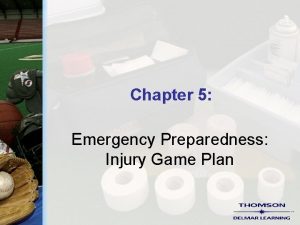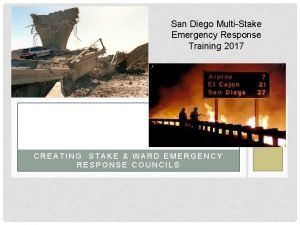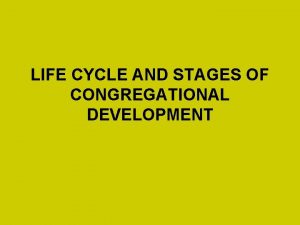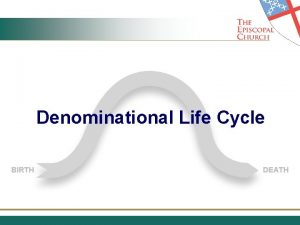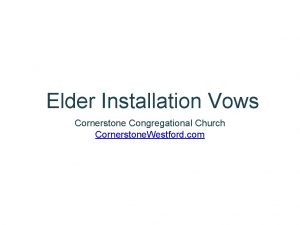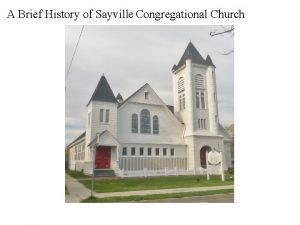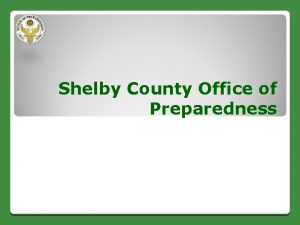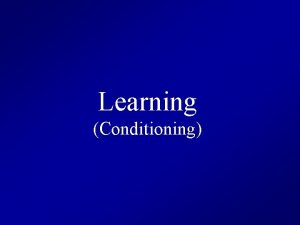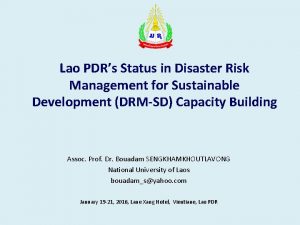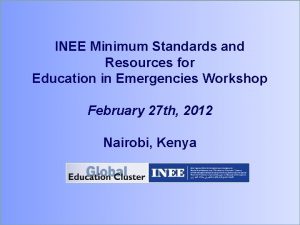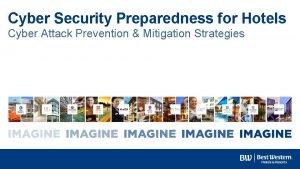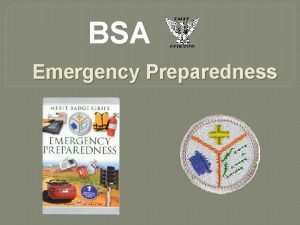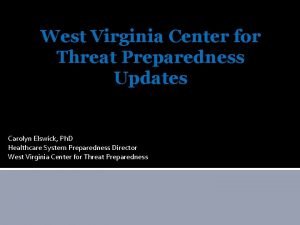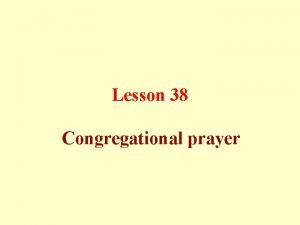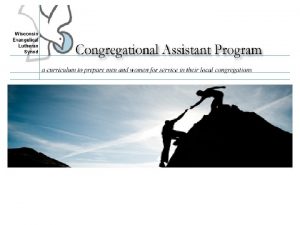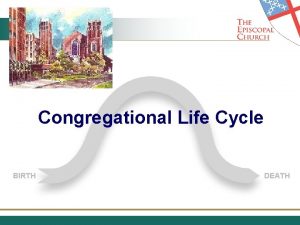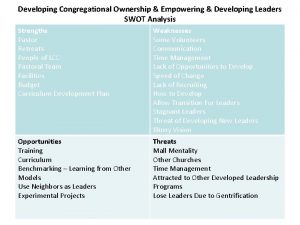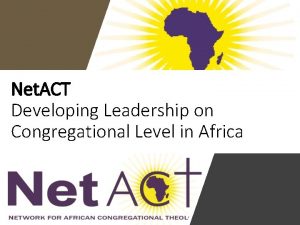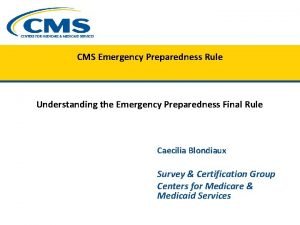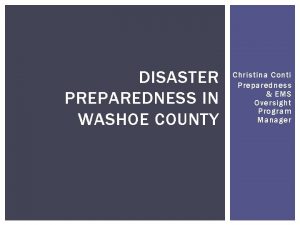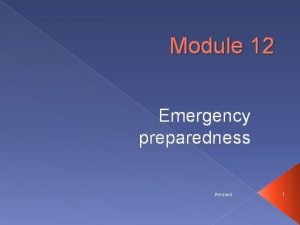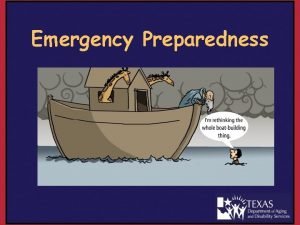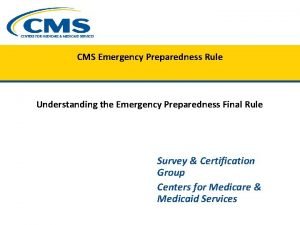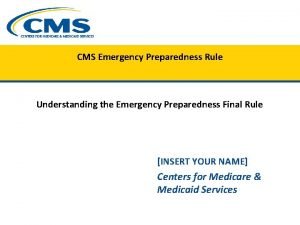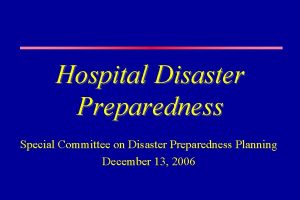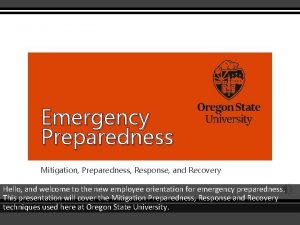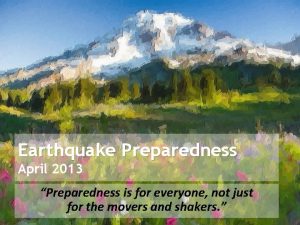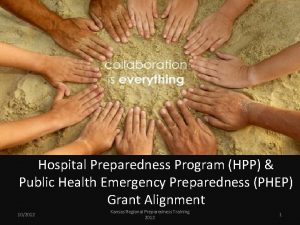Developing a Congregational Preparedness Plan Adapted from Congregational



































- Slides: 35

Developing a Congregational Preparedness Plan Adapted from Congregational Disaster Preparedness Guidebook by the ELCA

Goals of a Congregational Preparedness Plan

Goals of a Congregational or Organizational Plan • The goal of the process is to help a congregation or an organization to create a written, comprehensive preparedness plan that is approved by leadership, owned by the members of a congregation or the stakeholders of an organization and practiced and reviewed periodically. • For the sake of clarity, I will only mention congregations in the rest of the presentation. Please adapt the guidelines to organizations as you see fit.

Tasks of a Preparedness Plan • • • Task #1: Team, Purpose, Vision and Goals Task #2: Designate Members for Response Team Task #3: Conduct a Disaster Risk Assessment Task #4: Inventory Assets Task #5: Assessing Vulnerabilities Task #6: Identify Partners, Agreements and Resources

Tasks of a Preparedness Plan • • Task #7: Decision Making Process Task #8: Create a Communication Plan Task #9: Emergency Operations Task #10: Continuity of Ministries Task #11: Obtain Congregational Approval Task #12: Educate, Practice and Review Task #13: Always Going Deeper

The steps or tasks in this section are guidelines only. They can be modified to adapt to the contexts and realities of local organizations.

Task #1: Form a Collaborative Team, Clarify Purpose, Vision, Parameters and Set Goals

Task #1 • Form a Preparedness Team – Size – Representation of necessary stakeholders – Role of the top leader • Clarify Vision and Purpose – Engage members in a discussion of why we as Christians should respond to disasters in general and specifically for our community. • Define the Parameters of our Work – Focus only on safety of occupants? – Response only to needs of congregational members or to a wider community?

Task #I • Sample Goals: – – – – Protect the congregation’s assets (human and otherwise) Return to “normal” congregational life as quickly as possible Support impacted parishioners in their recovery Reach out to vulnerable neighbors (near and far) Protect and help people Reestablish Sunday worship as soon as possible Return church office to operational as soon as possible.

Task #2: Designate Members for Response Team

Task #2 • What is a Response Team? – The role of the Preparedness Team is to create a plan while the role of a Response Team is to execute the plan • Possible Roles in a Response Team – Chief Decision Maker – Backup Decision Maker – Other Roles?

TASK #3: Conduct a Disaster Risk Assessment

Task #3 • What types of Disasters will you most likely experience? – – – Storms Typhoons/Hurricanes Earthquakes Drought Human-made disasters Others

Task #3 – A Matrix to Assess Each Type of Disasters Probability Magnitude Warning Duration Risk Priority Highly likely Catastrophic Minimal 12+ hours High Likely Critical 6 -12 hours Medium Possible Limited 12 -24 hours 3 -6 hours Low Unlikely Negligible >24 hours >3 hours NO risk

Task #5 Assess the Vulnerabilities of the Congregation

Task #5 • Preventive Measures? – E. g. , necessary maintenance and Upkeep? – Things to do to prevent fire hazard • Vulnerabilities? – Entrance and exits to dismiss worshipers? – Elevators? – Ways to ensure safety for elderlies, children and those with disabilities? • What Problems, Weaknesses that Needs to Address?

Task #4: Inventory of the Assets of the Organization

Task #4 • What Assets do You Have? – – Human Assets Physical Assets Financial Assets Other Assets

Task #6 Identify Partners, Agreements and Resources

Task #6 • The Importance of Partners in Disaster Reponses – Who can be our partners in times of disasters? • Government agencies? Local Organizations? – What can we do together when disasters hit? • Establish and Maintain Relationships with Partner BEFORE Disasters – Informal or formal agreements?

Task #7 Decision Making Process

Task #7 • How Are Decisions Made in Times of Disasters? – Who will make what decisions? – How will decisions be approved and by whom?

Task #8 Create a Communication Plan

Task #8 • Communicate When Power or Phone Services Are Down – Communications between members and creating a communication tree – Communicate with local government, key leaders of community – Who will do what?

Task #9 Emergency Operations


Task #9 • Emergency Operation – What should we do when a disaster hits while we have a meeting or have worship service • Examples of An Emergency Operation Plan – Evaluation: All occupants must leave a specific area – Lock Down: All occupants inside a facility must remain inside and prevent an unauthorized person from entering the building – Shelter in Place; All occupants stay within a facility, perhaps for an extended period of time

Task #10 Planning for Continuity of Work or Ministry

Task #10 • Business Continuity Plan – What should we do when basic services – power, phone, water, etc. are interrupted and when there are significant damages and even casualties everywhere? – Which administrative functions and/or services will continue and which will be suspended temporarily? – Under what circumstances will suspended operations and functions resume?

Task #11 Obtain Approval of the Plan

Task #11 • Approval of the Plan – How should the plan be approved to make sure stakeholders agree to and embrace the plan?

Task #12 Communicate, Practice, Review and Adjust the Plan

Task #12 • Practice Your Plan – The Preparedness Team works with members to conduct practice drills so that the plans can easily be activated in times of disasters – Adjust the plan as needed.

Task #13 The Process Grows and Deepens Over Time

Task #13 • Updating Your Plan – The Preparedness Team should work with congregational leadership and members to constantly review and adjust the plan
 Chapter 5 emergency preparedness injury game plan
Chapter 5 emergency preparedness injury game plan Stake emergency preparedness plan
Stake emergency preparedness plan Congregational life cycle
Congregational life cycle Congregational life cycle
Congregational life cycle Congregational confession this is my bible
Congregational confession this is my bible Cornerstone westford
Cornerstone westford Sayville congregational church
Sayville congregational church This passage is adapted from jane austen
This passage is adapted from jane austen How are red blood cells adapted
How are red blood cells adapted Adapted with permission from
Adapted with permission from In what ways have the highland maya adapted to modern life?
In what ways have the highland maya adapted to modern life? Xerophytes
Xerophytes Chaparral biomass
Chaparral biomass Structural adaptation of camel
Structural adaptation of camel Sausage shaped organelles
Sausage shaped organelles The two brothers adapted
The two brothers adapted Adapted from the internet
Adapted from the internet Gallant
Gallant How have plants adapted to the rainforest
How have plants adapted to the rainforest Spermopsida plants
Spermopsida plants The outsiders adapted for struggling readers
The outsiders adapted for struggling readers Strengthen synoynm
Strengthen synoynm How are giraffes long necks adapted to their lifestyle
How are giraffes long necks adapted to their lifestyle Elements of observational learning
Elements of observational learning Shelby county office of preparedness
Shelby county office of preparedness Biological preparedness
Biological preparedness Biological preparedness
Biological preparedness Conclusion disaster management
Conclusion disaster management Preparedness mitigation response recovery
Preparedness mitigation response recovery Biological preparedness
Biological preparedness Promoting family earthquake preparedness
Promoting family earthquake preparedness Data breach preparedness
Data breach preparedness 1achors
1achors Chapter 36 emergency preparedness and protective practices
Chapter 36 emergency preparedness and protective practices Bsa emergency preparedness
Bsa emergency preparedness West virginia center for threat preparedness
West virginia center for threat preparedness
